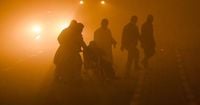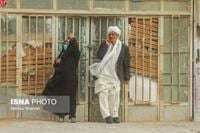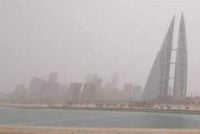KUWAIT CITY, April 15 (Xinhua) -- A powerful dust storm swept into Kuwait from the west on Monday, April 14, 2025, drastically reducing visibility across the country and prompting health and safety warnings from authorities. The storm's impact was felt nationwide, as residents were advised to take precautions due to the hazardous conditions.
As the dust storm moved from the west, visibility was significantly compromised, leading to concerns about air quality and public health. Local authorities urged citizens, especially those with respiratory issues, to remain indoors to avoid exposure to the dust-laden air. The storm not only affected Kuwait but also had significant repercussions in neighboring regions.
In Iran's Khuzestan province, Dr. Meisam Moazi, Deputy of Treatment at Ahvaz Jundishapur University of Medical Sciences, reported that around 20 patients were hospitalized due to the dust storm, with others discharged. The Khuzestan Meteorological Department issued a red-level warning for dust particles originating from Iraq and Saudi Arabia, expected to persist from late Monday until Tuesday. In response to the worsening air quality, all government offices in Khuzestan switched to remote work, and educational institutions suspended in-person activities on Tuesday, April 15.
In Ahvaz and Hamidiyeh, the concentration of PM10 pollutants skyrocketed to an alarming 67 times above the permissible limit, with 19 cities experiencing “hazardous” and “brown” air quality conditions. This alarming trend reflects a growing issue in the region, where dust storms have become increasingly frequent, attributed in part to climate change.
The situation in Iraq was even more dire, with more than 1,000 individuals suffering from respiratory problems after a sandstorm swept across the central and southern parts of the country. Health officials reported at least 700 cases of suffocation in Muthanna province alone. Hospitals in Najaf and Diwaniyah provinces reported over 250 and 322 patients respectively, while Dhi Qar and Basra provinces saw an additional 530 individuals with breathing issues. The sandstorm blanketed southern Iraq in a thick orange haze, reducing visibility to less than one kilometer (0.62 miles).
The authorities were compelled to shut down airports in Najaf and Basra due to the severe conditions. Footage shared on social media depicted areas enveloped in an orange cloud, with power cuts and flight suspensions reported in several regions. Experts warn that Iraq is among the five countries most vulnerable to climate change, facing regular sandstorms, extreme heat, and water scarcity. A severe sandstorm in 2022 left one person dead and over 5,000 needing treatment for respiratory illnesses, highlighting the ongoing health crisis exacerbated by environmental factors.
Meanwhile, in the United Arab Emirates (UAE), weather conditions on April 15, 2025, included fair to partly cloudy skies and a noticeable drop in temperatures. The National Centre of Meteorology (NCM) reported that dusty winds were expected to envelop parts of the country, with winds shifting from southeast to northwesterly, reaching speeds of up to 40 kilometers per hour. This weather pattern not only brought cooler temperatures but also stirred up dust, contributing to reduced visibility.
The temperature in Abu Dhabi was forecasted to hover between 27°C and 40°C, while Dubai experienced similar conditions with temperatures ranging from 27°C to 39°C. The winds were expected to intensify throughout the day, prompting warnings about dust and reduced visibility of less than 1,000 meters.
The NCM also forecasted a gradual drop in temperatures on Tuesday and Wednesday, with partly cloudy and occasionally dusty weather expected to persist until the weekend. Humidity levels were predicted to rise overnight, particularly in northern coastal areas, contributing to a sticky atmosphere for residents.
As the dust storms continue to sweep across the region, health officials are urging residents to take precautions. In Khuzestan, Dr. Moazi emphasized the importance of staying indoors, particularly for high-risk groups such as children, pregnant women, the elderly, and those with pre-existing respiratory conditions. The ongoing air quality crisis serves as a stark reminder of the environmental challenges faced by countries in the region, necessitating urgent attention and action.
In light of these severe weather conditions, it is crucial for residents of affected areas to remain vigilant and informed. The interplay between climate change and increasing frequency of dust storms underscores the need for comprehensive strategies to address air quality and public health in the face of environmental challenges.
As the situation develops, authorities across the region are closely monitoring air quality levels and providing updates to ensure the safety and well-being of their citizens. With climate change poised to exacerbate these conditions, the region must prepare for future dust storms and their associated health risks.
In conclusion, the recent dust storms sweeping across Kuwait, Iraq, and Iran highlight a growing environmental crisis that demands immediate attention. With health officials reporting alarming levels of respiratory issues and hazardous air quality, it is imperative for residents to prioritize their health and safety amidst these challenging conditions.










